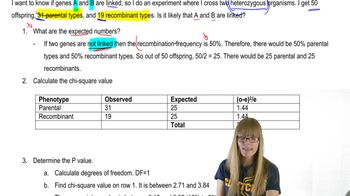Table of contents
- 1. Introduction to Genetics51m
- 2. Mendel's Laws of Inheritance3h 37m
- 3. Extensions to Mendelian Inheritance2h 41m
- 4. Genetic Mapping and Linkage2h 28m
- 5. Genetics of Bacteria and Viruses1h 21m
- 6. Chromosomal Variation1h 48m
- 7. DNA and Chromosome Structure56m
- 8. DNA Replication1h 10m
- 9. Mitosis and Meiosis1h 34m
- 10. Transcription1h 0m
- 11. Translation58m
- 12. Gene Regulation in Prokaryotes1h 19m
- 13. Gene Regulation in Eukaryotes44m
- 14. Genetic Control of Development44m
- 15. Genomes and Genomics1h 50m
- 16. Transposable Elements47m
- 17. Mutation, Repair, and Recombination1h 6m
- 18. Molecular Genetic Tools19m
- 19. Cancer Genetics29m
- 20. Quantitative Genetics1h 26m
- 21. Population Genetics50m
- 22. Evolutionary Genetics29m
4. Genetic Mapping and Linkage
Crossing Over and Recombinants
Problem 24d
Textbook Question
The boss in your laboratory has just heard of a proposal by another laboratory that genes for eye color and the length of body bristles may be linked in Drosophila. Your lab has numerous pure-breeding stocks of Drosophila that could be used to verify or refute genetic linkage. In Drosophila, red eyes (c⁺) are dominant to brown eyes (c) and long bristles (d⁺) are dominant to short bristles (d). Your lab boss asks you to design an experiment to test the genetic linkage of eye color and bristle-length genes, and to begin by crossing a pure-breeding line homozygous for red eyes and short bristles to a pure-breeding line that has brown eyes and long bristles.
How would the results of the cross differ if the genes are not linked?
 Verified step by step guidance
Verified step by step guidance1
Step 1: Begin by understanding the genetic setup. The pure-breeding line with red eyes and short bristles has the genotype c⁺c⁺d⁺d⁺, while the pure-breeding line with brown eyes and long bristles has the genotype ccdd. These genotypes are homozygous for their respective traits.
Step 2: Perform the initial cross between the two pure-breeding lines. The offspring (F₁ generation) will inherit one allele from each parent. Since red eyes (c⁺) and long bristles (d⁺) are dominant, all F₁ individuals will have the genotype c⁺cd⁺d and display the dominant phenotypes: red eyes and long bristles.
Step 3: To test for genetic linkage, perform a test cross. Mate the F₁ individuals (c⁺cd⁺d) with a homozygous recessive individual (ccdd). This will allow you to observe the segregation of alleles in the offspring (F₂ generation).
Step 4: If the genes are not linked, the alleles for eye color and bristle length will assort independently according to Mendel's law of independent assortment. This means the F₂ generation will display a phenotypic ratio of 1:1:1:1, corresponding to the combinations: red eyes with long bristles, red eyes with short bristles, brown eyes with long bristles, and brown eyes with short bristles.
Step 5: Analyze the phenotypic ratios of the F₂ generation. If the observed ratios deviate significantly from the expected 1:1:1:1 ratio, it suggests that the genes for eye color and bristle length may be linked. If the ratios match the expected 1:1:1:1, the genes are likely not linked.
 Verified video answer for a similar problem:
Verified video answer for a similar problem:This video solution was recommended by our tutors as helpful for the problem above
Video duration:
2mPlay a video:
Was this helpful?
Key Concepts
Here are the essential concepts you must grasp in order to answer the question correctly.
Genetic Linkage
Genetic linkage refers to the tendency of genes located close to each other on the same chromosome to be inherited together during meiosis. When genes are linked, the assortment of alleles does not follow Mendel's law of independent assortment, leading to a higher frequency of parental combinations in the offspring. Understanding linkage is crucial for predicting the outcomes of genetic crosses and interpreting the results.
Recommended video:
Guided course

Chi Square and Linkage
Mendelian Inheritance
Mendelian inheritance is the set of principles that describe how traits are passed from parents to offspring through alleles. It includes concepts such as dominance, segregation, and independent assortment. In the context of the experiment, if the genes for eye color and bristle length are not linked, the offspring will exhibit a phenotypic ratio consistent with Mendelian predictions, specifically a 9:3:3:1 ratio in a dihybrid cross.
Recommended video:
Guided course

Organelle Inheritance
Phenotypic Ratios
Phenotypic ratios represent the relative frequencies of different phenotypes in the offspring resulting from a genetic cross. In a typical dihybrid cross involving two traits, if the genes are unlinked, the expected phenotypic ratio is 9:3:3:1. This ratio helps in determining whether the observed results align with Mendelian expectations, thus indicating whether the genes are linked or assort independently.
Recommended video:
Guided course

Mutations and Phenotypes
Related Videos
Related Practice
Textbook Question
Are mitotic recombinations and sister chromatid exchanges effective in producing genetic variability in an individual? in the offspring of individuals?
431
views


